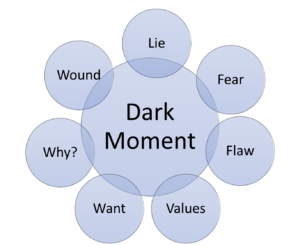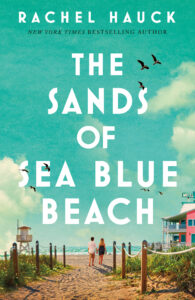By Rachel Hauck
I’ve been using Susan May Warren’s Story Equation (SEQ) for building characters and working out a high-level plot for over a decade.
In our early days of writing, as Susie and I talked about our craft, she brought these principles to the table and created The Story Equation.
To be clear, there are many good author tools. What I love about the SEQ is it provides a “how” to the “what” of an author’s toolbox.
We know all characters need a what? Character arc or journey. But how do we work it out on the page? All characters need a competence and a flaw. But how do we show those elements?
That’s the beauty of the SEQ. For this blog, let’s focus on the basic SEQ.

I’ve been teaching the full equation quite a bit lately and I always start with, “You’re going to feel like I’m hitting you with a fire hose but stay with me.”
Craft takes time to learn and perfect. Be patient with yourself.
Let’s start with the Dark Moment Story (DMS). Every character has an issue in their past that caused a Wound. Usually, this happens to a child or young teen who lacks the maturity to handle the situation. For example, a child develops a Wound because of his parents’ divorce or when one dies. He may blame himself or develop a sense of fear and insecurity because he feels abandoned.
Maybe your protagonist was sickly as a kid and always felt left out. Or perhaps she was a military “brat” and was never in one place long enough to make friends.
The Wound, caused by a specific event, is an emotional response to external happenings. It becomes a story your protagonist shares with another character to deepen the relationship. In romance, the heroine shares with the hero and vice versa. In contemporary or women’s fiction, friends or sisters share the DMS. In a military or sci-fi, perhaps the protagonist shares with a love interest or a fellow warrior.
The Wound forms a Lie, such as: “I’m no good.” “I’m not beautiful.” “I’m the reason my parents divorced.” “I’ll never find love.”
If the Wound happens to a child, his lie might be feelings of guilt for something he could not possibly be responsible for—like death or divorce. If the Wound happens when the protagonist is a teen, the lie must be rooted in reality. For example, the protagonist was told to watch her little brother in the pool, but when she decided to go to the snack bar, she missed his fall into the water. He was rescued but her mother said all kinds of horrible things over her. Twenty years later, she carries those words as truth.
From the Lie, the protagonist develops a Fear. Fear of being alone. Fear of ruining other people’s lives. Fear of regret. Fear of taking a chance.
In one of my Nashville books, the protagonist, Robin Rae, is desperate to be a country songwriter but she’s also terrified to sing in front of people. I had yet to learn about the Wound and the Lie portion of the DMS, but I knew enough to give my heroine a dream that her fear held prisoner.
The Wound→ Lie→ Fear is propelled forward by the Inciting Incident. The story opens with the protagonist in normal life until something happens to awaken the Secret Desire or Greatest Dream. It knocks on the protagonist’s heart, declaring, “I want out!”
This event inspires your character to take a chance, try something new, go for a different life. Along the way, she’ll learn truthlets from a Voice of Reason or Truth. She’ll try something she’s never tried before and succeed. She’ll try things and fail. She’ll fall in love. She’ll lose that love then, try again. She’ll overcome.
The Second Act ends with the Black Moment where all seems lost. But our protagonist has changed. She’s learned things, grown in truth, understands she’s believed a Lie, and lived in Fear. She’s had an Epiphany that brings healing to the Wound. She is able to push through for Help, Overhaul the situation, and arrive at a Happy or Satisfying Ending.
But it all begins with the Dark Moment Story (DMS). When crafting this moment for your protagonists, take the time to create an actual event in the past. The story must be specific, relatable, and poignant. Then put the story in dialog with another main character around the middle of the book to bring clarity to the reader and build intimacy.
Don’t forget to check out The Story Equation by Susan May Warren.
Go write something brilliant!
 Rachel Hauck is an award winning, New York Times, USA Today and Wall Street Journal bestselling author. She is a writing workshop presenter and mentor, and has earned the Mentor of The Year award from ACFW. A graduate of Ohio State University (Go Bucks!) with a degree in Journalism, she’s a former sorority girl and a devoted Ohio State football fan. Her bucket list is to stand on the sidelines with Ryan Day. She and her husband live in sunny east coast Florida.
Rachel Hauck is an award winning, New York Times, USA Today and Wall Street Journal bestselling author. She is a writing workshop presenter and mentor, and has earned the Mentor of The Year award from ACFW. A graduate of Ohio State University (Go Bucks!) with a degree in Journalism, she’s a former sorority girl and a devoted Ohio State football fan. Her bucket list is to stand on the sidelines with Ryan Day. She and her husband live in sunny east coast Florida.

Comments 2
Thanks for the article! The high points of the arc helped me better understand how my characters develop during the writing process. Up to now, with a basic character outline in place, I tend to walk through the arc as the plot unfolds. I see the value of addressing the wound, the lie and the fear right up front. Before I start the first major edit of the next book in my series, I’m going to document the arc in advance as a sort of guide. I believe it will add that much more continuity to the story line and how the character is involved in that story line. Thanks!
Thanks for sharing this great information, Rachel! The Story Equation makes so much sense.